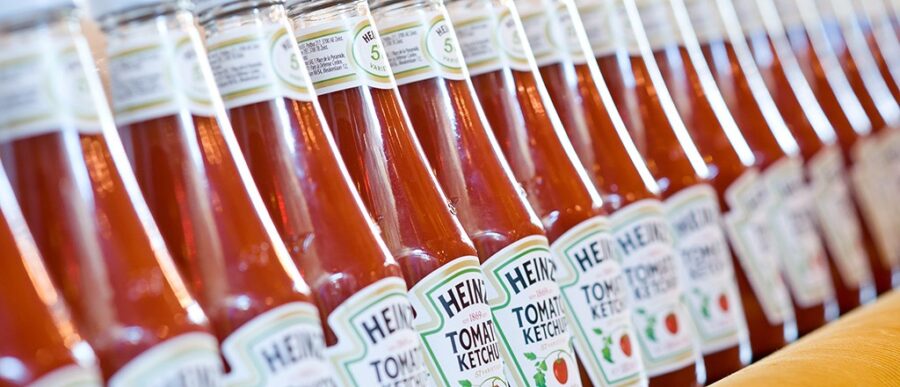At the end of February, when Kraft Heinz posted a $12.6 billion loss for 2018 and slashed its dividend by 36%, it wasn’t hurting for a lack of customer loyalty. The foods company has a brand portfolio that crowds supermarket shelves and must be the envy of rivals – Maxwell House coffee, Velveeta, Planters nuts, Jell-O, Oscar Mayer, and of course Kraft macaroni and cheese and Heinz ketchup. To boot, it also has Warren Buffett’s Berkshire Hathaway as its biggest investor with a 26.7% equity stake; New York City-based private equity firm 3G Capital is the next biggest investor with a 23.9% stake.
Kraft Heinz CEO Bernardo Hees blamed higher manufacturing and logistics costs with rising commodity prices and the inability to extract more savings from the 2015 merger between Kraft and Heinz. However, a millstone has been its long-term debt of nearly $31 billion, which works out to a leverage multiple of 4.4 times its 2018 adjusted earnings, as a CNN report noted. Its interest costs for the year were nearly $1.3 billion, while sales at $26.3 billion grew barely 0.7% over those in 2017, according to the company’s SEC filing.
The outlook for the current year, too, is not encouraging. The company posted lower EBITDA (earnings before interest, depreciation, taxation and amortization) of $7 billion for 2018, compared with $7.8 billion for 2017. In its analyst call, it warned of a further decline in 2019 adjusted EBITDA to between $6.3 billion and $6.5 billion.
To right its ship, the company needs to reduce its debt and focus on longer-term growth drivers, notably by recasting its product portfolio in ways that reflect the general shift towards healthier foods, experts say.
According to David Kass, clinical professor in the department of finance at the University of Maryland’s Smith School of Business, the company has to rethink the post-merger strategy it has followed of improving profit margins by extracting savings from acquisitions. “It will take them some time to reduce debt and to refigure the economics of the industry that they are in,” he said.
“This is not the same game that they thought they were playing in terms of steady and stable growth, [where they] just cut expenses,” Kass continued. “To succeed going forward, they have to find out exactly what it is consumers want and to try to satisfy that.” That approach will call for investments in R&D, innovation and marketing — “areas that [PE investor] 3G Capital has not been strong in,” he added.
“I worry about old dogs and new tricks and whether or not they’re going to be able to change,” said Wharton marketing professor David Reibstein. He noted that typically, companies in similar situations attempt to cut marketing costs while protecting the future, which he said Kraft Heinz hasn’t been doing. “People are shopping differently, and what they’re shopping for is changing as well. The companies that are going to survive are those that adapt.”
Reibstein also pointed out that Kraft Heinz has steadily reduced its advertising spend in recent years — from more than $600 million in 2014 to less than $450 million in 2017 (figures for 2018 were not immediately available). “We see a steady removal of advertising behind their brands,” he said. “A brand needs more than just advertising, but it does also need advertising. They’re taking that money and watching it fall to the bottom line in the short-term, but they’re not looking at the long-term consequences.”
Kass and Reibstein discussed the ways in which Kraft Heinz could revive its fortunes on the Knowledge at Wharton radio show on SiriusXM. (Listen to the podcast at the top of this page.)
With last year’s disappointing performance, the company’s brand portfolio also took a valuation hit as Kraft Heinz wrote down the value of its Kraft and Oscar Mayer brands by $15.4 billion. When Kraft Foods and Heinz merged, it had assigned a valuation of $47.8 billion to the value of their brands. “The write-down suggests the company may have lowered its expectations for the performance of those brands,” said a Wall Street Journal report. On top of those woes, the Securities and Exchange Commission is investigating the company’s accounting practices in the procurement area. Kraft Heinz said it is cooperating with the regulator.
“I worry about old dogs and new tricks and whether or not they’re going to be able to change.” –David Reibstein
In the short run, Kraft Heinz plans to raise nearly $1.9 million by selling some brands in India and in Canada, and is considering raising another $3 billion by selling its Maxwell House brand. The company’s dividend cut also saved it about $1 billion.
Rethinking the Portfolio
Kraft Heinz has to identify its most profitable products and innovate to create “byproducts or similar products under those brand names,” said Kass. However, the first goal must be to reduce its debt, because only then could it “even begin to think of going back on the acquisition path,” he added.
Reibstein had two concerns with how the company might recast its product portfolio. One is that by selling off some products, it would get smaller. Secondly, he suggested that it may not be a good idea to use the proceeds from those sales to modify the existing product portfolio, especially around brands like Oscar Mayer, which many people associate with hot dogs. “If people are moving towards healthier eating [habits], are you going to be able to do it under the Oscar Mayer name?” he wondered. “What they’re going to need to do is create new brands that have totally different positioning and images, and are healthier.”
Brand equity is critical for Kraft Heinz, said Reibstein. Many of its brands are staple foods, and demand will continue to exist for them. Alongside, “it is not like everybody’s moving [towards] healthier [foods],” he noted. Therefore, while the company tweaks its portfolio to reduce the calories and preservatives in its products, it has to work to strengthen existing brands, too.
“It will take them some time to reduce debt and to refigure the economics of the industry that they are in.” –David Kass
Help from Top Investors
How ready are Kraft Heinz’s biggest investors to help turn the company around? Already, there is some buyer’s remorse. Warren Buffett told CNBC last week that he overpaid when Berkshire Hathaway and 3G Capital bought H.J. Heinz in 2013, and later funded the acquisition of Kraft Foods. The day after the company reported its 2018 results, Buffett lost nearly $4.3 billion as the stock plunged 27% to $34.95.
Kass noted Buffett’s lament that Kraft Heinz faced strong competitive pressure from Amazon, Walmart and Costco. He said Buffett’s reference to the success of the Kirkland brand of Costco may be like “comparing apples with oranges,” but noted that the larger point was the need to deal with competition from private labels. Kraft Heinz is “sleeping with the enemy” by selling through Walmart and Costco “because they feel they have to be in those outlets,” said Reibstein.
In recasting the brand portfolio at Kraft Heinz, 3G Capital has to bring in expertise “to innovate and properly market, and promote those brands that are perceived by the consumer as being healthy, free of preservatives, including organic foods,” Kass advised.
According to Kass, “the problem resides within the Kraft side of Kraft Heinz — the Heinz side is perfectly fine.” Its partner 3G Capital has to get its act together, he suggested. “Does 3G Capital have as part of their DNA the ability to innovate, do the R&D, come out with new products and succeed in marketing them? That is the question going forward. They will be forced to develop that skill,” he said.



